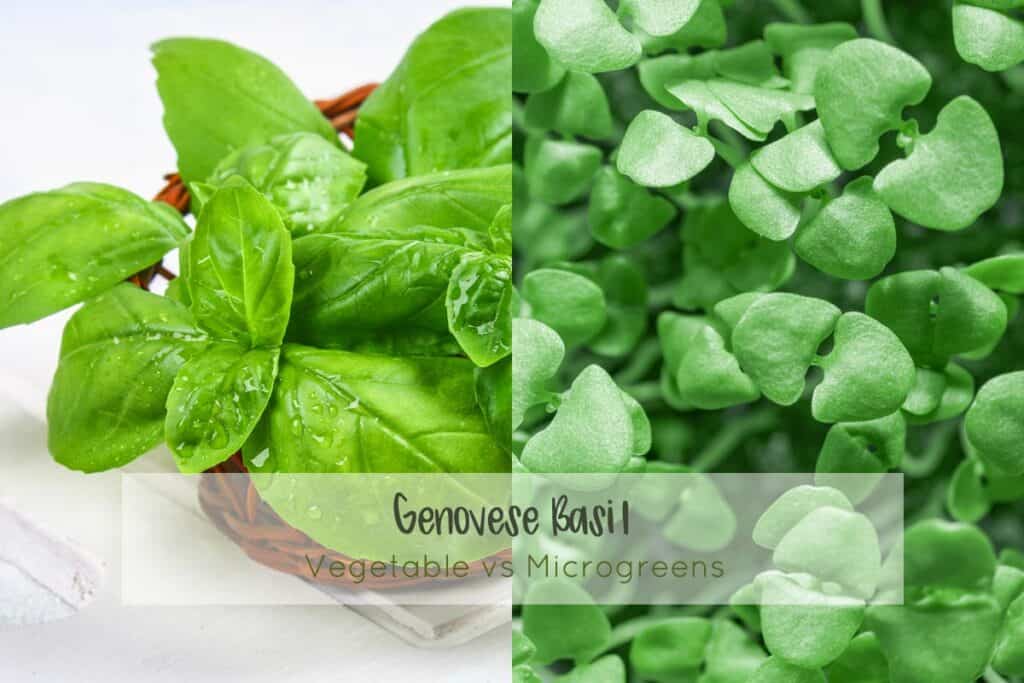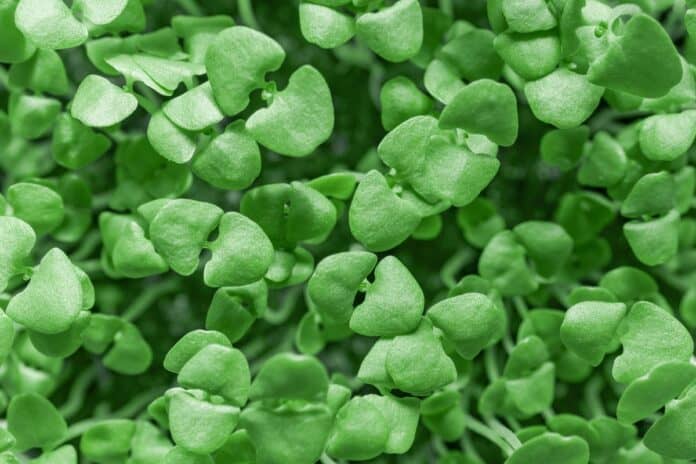Genovese Basil microgreens are delicious and a great alternative to the regular full-grown vegetable. As microgreens, they grow fast and provide an even more intense taste! Mix them with your pesto, sprinkle on the pizza, or eat fresh!
What are Genovese Basil Microgreens?
The Genovese Basil is the most common variety of basil, and as microgreens, they are tasty with an intense flavor. It belongs to the Lamiaceae family (mints), and it’s easy to grow. Compared to many other microgreens, basil seeds take a longer time to germinate, but it’s well worth the wait!
| Growing period | 12-16 days |
| Flavor | Strong, sharp but often sweet taste |
| Growing difficulty | Medium |
| Buy seeds | Genovese Basil seeds from True Leaf Market Dark Opal Basil seeds from True Leaf Market Genovese Basil seeds from Amazon |
Description
Basil is one of the more popular herbs, and it’s said to have its origin in India. It has a long history being grown for more than 4000 years, and today it’s used in cuisines worldwide, especially famous for use in Italian and Asian cuisine.
You can use the Genovese Basil in so many varieties of dishes, and that is why it makes it a popular microgreen to grow at home. It’s great for use not only in pesto, pasta, and pizzas, but as well in salads, and on many types of meat and vegetable dishes.

General Nutrition & Benefits
The plant is rich with vitamin K, zinc, calcium, magnesium, and potassium. It’s practically calorie-free and a great healthy addition to your diet.
RELATED: The Most Nutritious Microgreens to Grow and Eat
How to Grow Genovese Microgreens
Genovese Microgreens are slow growers, and it can take around a week for it to germinate and an additional ten days before you are ready to harvest.
| Growing timeline (estimated) | |
|---|---|
| Presoak | No |
| Preferred medium | Hydroponic or soil |
| Avg. seed weight (10/20 tray) | 10 grams |
| Germination period (blackout) | Day 1-5 |
| Growth time (sunlight) | Day 6-11 |
| Harvest | Day 12-16+ |
What differs Genovese Basil seeds from others, are that they are gelatinous when wet (similar to chia). That means they seem to expand and get a jelly-like coat when you give them water. Because the seeds get sticky with mucilage gel, you may consider them more difficult to grow, but they are not. The jelly-like coated layers on the seeds don’t indicate any failure, and they will grow into beautiful green microgreens.
You don’t have to presoak the seeds before you plant them. Just sprinkle them evenly across the medium. They are great to grow in coconut coir or another soilless medium.
The seeds are fairly small, so ensure that you don’t place too many on top of each other. It can cause them to grow unevenly, and they may show signs of mold.
To support the germination process, place your tray in the dark. Keep the seeds covered up for up to a week or until you see they have germinated.
During the entire growth, ensure that you keep your crop moist but never soaked. Basil does not stand to dry out nor over-watering. Mist the seeds until sprouted, and the roots have grown with a good grip. If you are using a container with drainage holes, you can use the technique of bottom-watering. Place a tray below the container and water it from beneath. It will enable the medium to absorb the water and keep the roots wet.
After around a week, you are ready to bring them out in the light. Basil microgreens need a lot of light but not direct burning sunlight.
The Genovese Basil doesn’t grow tall, and you can harvest them when they are about an inch or two high. Use a sharp knife or scissors and cut just above the medium level.
Culinary Guiding
Basil and tomatoes are a match made in food heaven! You can use the Genovese Basil microgreens the same way as you would with the full-grown herb.
They add the same or even more intense flavors to many dishes. Use them in your pesto, sprinkle them over the pizza, mix in salads, or serve with tomatoes and feta cheese. The use of these microgreens in meals is near to endless!



